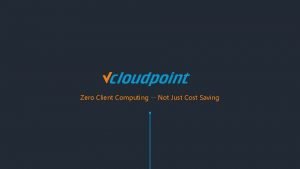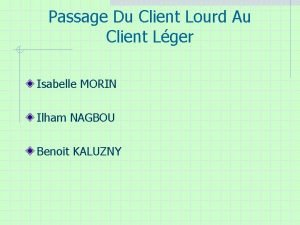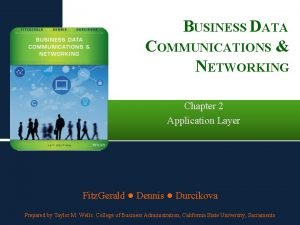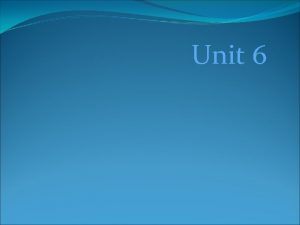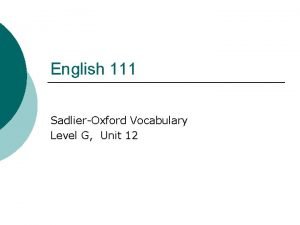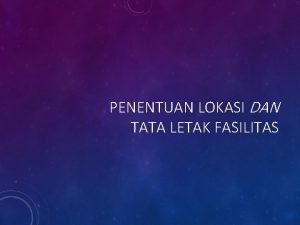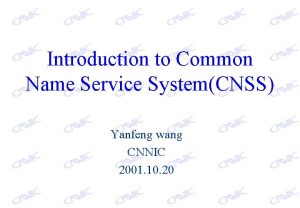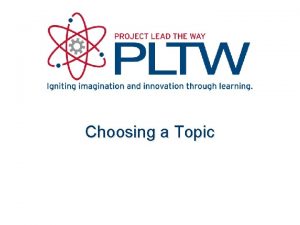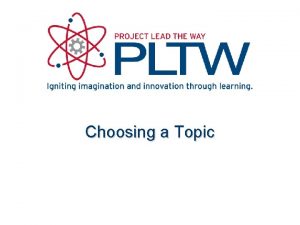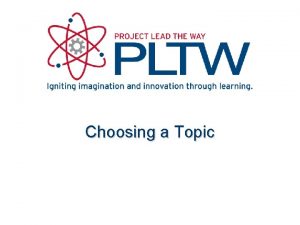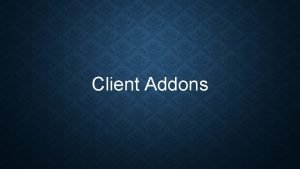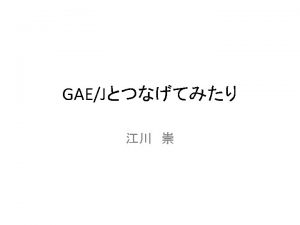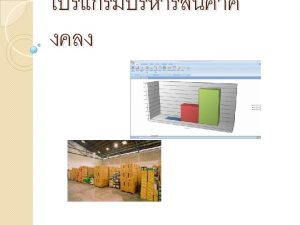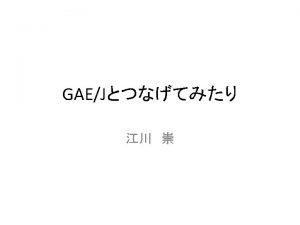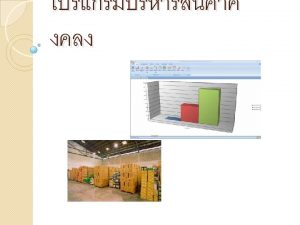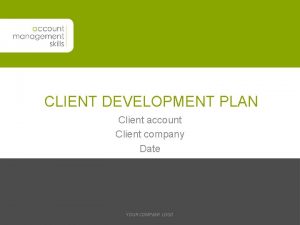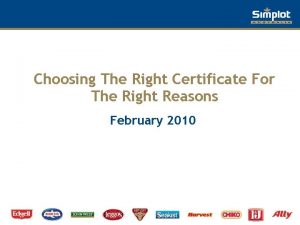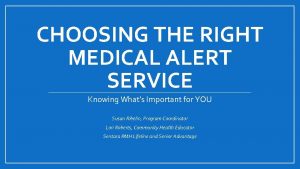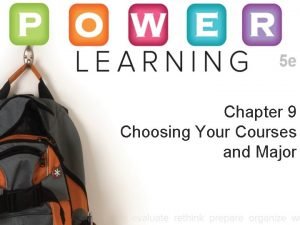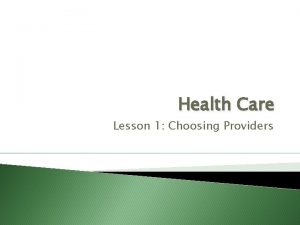Choosing the Right Service for the Right Client


































- Slides: 34

Choosing the Right Service for the Right Client at the Right Time February 2017 1

Referral Process • Referral Management Process through KEPRO for: – (ITRT) Intensive Temporary Residential Treatment – (HCT) Section 65 Home and Community Based Treatment – (RCS 28) Section 28 Rehabilitation and Community Support • (MST & MST-PSB) Multi-systemic Therapy – Problem Sexual Behavior • (FFT) Functional Family Therapy 2

Role of Case Manager • The Case Manager is one of the major gateways through which Mainecare clients enter the CBHS system of care. The system depends on CMs to: – – – Engage in often chaotic family systems with high anxiety and stress levels Make thorough assessments of the needs and strengths of clients and families Be knowledgeable of community services or know where to find them. Understand what issues each service is meant to treat or address Understand the referral process for which the referrals flow • Because of the complexity of the system and staff attrition in Case Management, ongoing training and communication is required in the system at the State level and within the individual agencies. • The purpose of this training is to contribute to this learning process…. 3

Role of Case Manager (Cont. ) Some Clarifications on common issues to be aware of: – Being careful that the CMs assessment drives the service referrals and not the anxiety and stress level of the family: • Often the family is desperate for help and the CM may feel pressure to simply begin referring to many services before they have been able to gather a sense of the family needs. This can lead to referrals for services that will not adequately meet the client need, treatment failure, client and provider frustration, and increased intensity of the need not being addressed. – Incorrectly referring clients with “Mental Health” needs (e. g. ADHD, Anxiety, Trauma) to a non-mental health service such as RCS 28: • Although many DD/ID and MH clients may possess functional limitations, the etiology of the functioning deficit is likely different and requires a different intervention. Outpatient or HCT is typically more appropriate for Mental Health based functional deficits. – The “Monitoring” function of CM is an active process: • This has led to numerous service denials and frustrations in the system. Monitoring is a active/action-based service component and it must be articulated as such. Calling providers for follow-up, meeting with clients and providers to see if the interventions remain effective, etc. …are all monitoring functions if they are for the purpose of maintaining forward progress on IPC goals. 4

Referral Role of Case Manager • 13. 02 Comprehensive Assessment and Periodic Re-assessment of an eligible member to determine service needs, including those activities that focus on needs identification, to determine the need for any medical, educational, social or other services. The comprehensive assessment and re-assessment must be conducted through face-to-face contact with the member and, where appropriate, consultation with other providers and with the member's family. – What is the need? – How active can family be in treatment? – What is/are the appropriately assessed service(s)? – What is plan if the service(s) is/are not available? • Referral activity for case management is completed once the referral and linkage has been made. • Monitoring and Follow-Up Activities (Monitoring is an ACTIVE process) that includes activities and contacts that are necessary to ensure that the Individual Plan of Care is effectively implemented and adequately addresses the needs of the eligible member – Is member on the Referral Management list? – Has members demographics changed that will effect service? – Has there been a change in providers? – Has there been a change in need so that family no longer requests the services or if member is now a priority for services? 5

(ITRT) Section 97 • ITRT must be provided in the least restrictive environment possible. • Placement should be as close to the child’s home as possible. • Families must remain as actively involved as possible in their child’s care and treatment. • The purposes of ITRT is to provide all required services to both treat the mental illness/disorder and to return the child to his/her family, home and community as soon as possible. • Documentation to support ITRT should be within the past 60 days ONLY. 6

(ITRT) Mental Retardation and Pervasive Developmental Disorder (PDD) Conditions Basic Criteria for all (ID/DD): All of the following criteria set forth below must be met, in addition to criteria for either Level I or Level II services, as detailed below. The child must have: • An Axis I or II diagnosis from the most current version of the DSM and; • A disorder that has lasted for at least six (6) months or is expected to last for at least one (1) year in the future, and • A current need for therapeutic treatment or availability of a therapeutic on-site staff response on a twenty-four hour basis, and • A disorder that is amenable to treatment in a residential setting, and • Even with intensive community intervention, including services and supports, there is significant potential that the child will be hospitalized, or there is a clear indication that the child’s condition would significantly deteriorate and would require a higher model of service than can be provided in the home and community. In addition to the above criteria, the child must meet the following criteria for either Level I or Level II services: 7

(ITRT) Mental Retardation and Pervasive Developmental Disorder (PDD) Conditions (Cont. ) Level I Criteria (ID/DD) • • Significant recent aggression across multiple environments or severe enough within one environment to have caused serious injury or there is significant potential of serious injury to self or others; or Recent homicidal ideation with risk of harm to others, or • Recent suicidal ideation with risk of harm to self; or • Symptoms of mental retardation (Intellectual Disability) or Pervasive Developmental Disorder so severe that it results in an inability to care for oneself to a developmentally appropriate level even with home and community supports and services; or • Has not responded to less restrictive level of care or would have a significant risk of harm to self or others if a less restrictive setting were attempted; and • An assessment using the Children’s Habilitation Assessment Tool (CHAT) with a score of 30 or higher or Global Assessment Functioning (GAF) tool score of 50 or lower with description of specific symptoms justifying the score. 8

(ITRT) Mental Retardation and Pervasive Developmental Disorder (PDD) Conditions (Cont. ) Level II Criteria (ID/DD) • The Child must meet all the level I service criteria and in addition… • Frequency, intensity and duration of intervention required to address daily repeated aggression and potential for harm to self or others, or • Frequency, intensity and duration of assistance required to address activities of daily living and potential for harm to self or others either directly or as a consequence of being unable to maintain ADL’s and • Children’s Habilitation Assessment Tool (CHAT) score of 35 or higher, or a Global Assessment Functioning (GAF) score of 40 or lower with description of specific symptoms justifying the score. 9

(ITRT) Child Mental Health Conditions Basic Criteria for all (MH): All of the following criteria set forth below must be met, in addition to criteria for either Level I or Level II services, as detailed below. The child must have: • The child must have either an Axis I or II diagnosis from the most current version of the DSM, and • The child’s disorder has lasted for at least six (6) months or is expected to last for at least one year in the future, and • The child has a current need for therapeutic treatment or availability of a therapeutic on-site staff response on a twenty-four hour basis, and • The child’s disorder is amenable to treatment in a residential setting, and • Even with intensive community intervention, including services and supports, there is significant potential that the child will be hospitalized, or there is a clear indication that the child’s condition would significantly deteriorate and would require a higher model of service than can be provided in the home and community. In addition, the child must meet the criteria below for Level II services: 10

(ITRT) Child Mental Health Conditions (Cont. ) Level I Criteria (MH) • Significant recent aggression across multiple environments or severe enough within one environment to have caused injury or there is significant potential of injury to self or others; or • Recent homicidal ideation with risk of harm to others, or • Recent suicidal ideation with risk of harm to self; or • Symptoms of mental illness so severe that it results in an inability to care for oneself in a developmentally appropriate manner, even with home and community supports or services; or • Has not responded to less restrictive model of service or would have a significant risk of harm to self or others if a less restrictive setting were attempted; and • A Child and Adolescent Functional Assessment Scale (CAFAS) score of 100 or higher or Global Assessment Functioning (GAF) score of 50 or lower with description of specific symptoms justifying the score. 11

(ITRT) Child Mental Health Conditions (Cont. ) Level II Criteria (MH) • Frequency, intensity and duration of intervention required to address daily repeated aggression and potential for harm to self or others, or • Frequency, intensity and duration of assistance required to address Activities of Daily Living and potential for harm to self or others either directly or as a consequence of being unable to maintain ADL’s and • A Child and Adolescent Functional Assessment Scale (CAFAS) 8 scale score of 120 or higher, or Global Assessment Functioning (GAF) score of 40 or lower with description of specific symptoms justifying the score. 12

(RCS 28) REHABILITATIVE AND COMMUNITY SUPPORT SERVICES • Completed DSM or DC-03 diagnosis and; • Have a functional assessment administered within one (1) year prior to the date of the referral documenting functional impairment measured as two (2) standard deviations below the mean on the composite score or have one point five (1. 5) standard deviations below the mean on the composite score and two standard deviations below the mean in the communication or social domain sub score of the most current version of the Vineland Adaptive Behavior or The Adaptive Behavioral Assessment Scales ABAS or • Have a functional assessment administered within one (1) year prior to the date of the referral documenting functional impairment measured as two (2) standard deviations below the mean on the Developmental Quotient of the Battelle Developmental Inventory or have 1. 5 standard deviations below the mean on the Developmental Quotient and two (2) standard deviations below the mean on in the Personal-Social, Adaptive, Communication, or Cognitive subscales, or • Have a functional assessment administered within one (1) year prior to the date of the referral documenting functional impairment measured as two (2) standard deviations below the mean on the composite Adaptive Score of the Bayley Scales of Infant and Toddler Development or have 1. 5 standard deviations below the mean on the composite Adaptive Score and two (2) standard deviations below the mean on the Social or Communication domain or Cognitive, Language or Social Emotional Subscale, or • Other functionally equivalent tools approved by DHHS and other clinical assessment information obtained from the member and family; OR 13

(RCS 28) REHABILITATIVE AND COMMUNITY SUPPORT SERVICES (Cont. ) • • A member aged birth through five (5) years, who has a diagnosis from a physician (including psychiatrist) of a specific congenital or acquired condition, and a written assessment by a physician (including psychiatrist) that there is a significant probability that because of that condition, the member will meet the functional impairment criteria in (C)(1) above, later in life if medically necessary services and supports are not provided to the member; Family Participation is required in treatment services to the greatest degree possible given the individual needs as well as family circumstances (Vineland) Adaptive Behavior: http: //psychcorp. pearsonassessments. com/HAIWEB/Cultures/en-us/Productdetail. htm? Pid=Vineland-II (ABAS) The Adaptive Behavioral Assessment Scales : http: //www. pearsonassessments. com/HAIWEB/Cultures/en-us/Productdetail. htm? Pid=015 -8004507&Mode=summary Battelle Developmental Inventory http: //www. riverpub. com/products/bdi 2/index. html Bayley Scales of Infant and Toddler Development http: //www. pearsonassessments. com/haiweb/cultures/en-us/productdetail. htm? pid=015 -8027 -264 14

(HCT) Section 65 Home and Community Treatment Services • This treatment is for members in need of mental health treatment based in the Home and Community (excluding school settings) who need a higher intensity service than Outpatient but a lower intensity than Children’s ACT. • The services assist the member and parent or caregiver to understand the member’s behavior and developmental level including co-occurring mental health and substance abuse, teaching the member and family or caregiver how to appropriately and therapeutically respond to the member’s identified treatment needs, supporting and improving effective communication between the parent or caregiver and the member, facilitating appropriate collaboration between the parent or caregiver and the member, and developing plans and strategies with the member and parent or caregiver to improve and manage the member’s and/or family’s future functioning in the home and community. • Services include therapy, counseling or problem-solving activities in order to help the member develop and maintain skills and abilities necessary to manage his or her mental health treatment needs, learning the social skills and behaviors necessary to live with and interact with the community members and independently, and to build or maintain satisfactory relationships with peers or adults, learning the skills that will improve a member's self-awareness, environmental awareness, social appropriateness and support social integration, and learning awareness of and appropriate use of community services and resources 15

(HCT) General Eligibility Requirements Have a medically necessary need for the service, defined as follows : • DSM or DC-03 diagnosis within thirty (30) days of the start of service. – Excludes, the following: Learning Disabilities (LD) in reading, mathematics, written expression, Motor Skills Disorder, and LD NOS (Learning Disabilities Not Otherwise Specified), Communication Disorders (Expressive Language Disorders, Mixed Receptive Expressive Language Disorder, Phonological Disorder, Stuttering, and Communication Disorder NOS); and • Have a significant functional impairment (defined as a substantial interference with or limitation of a member’s achievement or maintenance of one or more developmentally appropriate, social, behavioral, cognitive, or adaptive skills), and • Have a diagnosis of a serious emotional disturbance for one (1) year or likely to last more than one (1) year; and • Determination of the appropriate level of care based on the Child/ Adolescent’s Level of Functional Assessment Score – (CAFAS) or Preschool and Early Childhood Functional Assessment Scale (PECFAS), (CAFAS/PECFAS no longer required) other tools (YOQ) approved by DHHS and other clinical assessment information obtained from the member and family; (later in 2017, CANS will be approved tool to replace the YOQ) and • Need treatment that is more intensive and frequent than what he or she would get in Outpatient and a lower intensity than Children’s ACT; and • If the member is living with the parent or guardian the parent/guardian must participate in the member’s treatment, consistent with the ITP. 16

HCT Referral Management Process • See Referral Management Flow Chart: http: //www. qualitycareforme. com/media/1657/refmanagment-flow. pdf 17

MST / MST-PSB / FFT Referral Information • Multisystemic Therapy (MST) • Multisystemic Therapy - Problem Sexual Behavior (MST-PSB) • Functional Family Therapy (FFT) – It’s important to consider whether MST, MST-PSB, or FFT may be appropriate for your clients. Often times client’s who may be well served in these Evidence-based practices are referred directly to HCT instead. 18

MST / MST-PSB / FFT Referral Information • Multisystemic Therapy (MST) • Here a few basic eligibility requirements for MST: – Ages 12 -17. 5 – Physical aggression at home or school – Externalizing behavior resulting in diagnosis of Conduct Disorder or other Disruptive Behavior disorders – Criminal or delinquent behavior – Risk of Out of Home placement – Multiple system involvement – Verbal aggression or verbal threats 19

MST / MST-PSB / FFT Referral Information • Multisystemic Therapy - Problem Sexual Behavior (MST-PSB) • Here a few basic eligibility requirements for MST-PSB: – Ages 10 -17. 5 – Has been engaged in sexually assaultive behavior with another person 20

MST / MST-PSB / FFT Referral Information • Functional Family Therapy (FFT) • Here a few basic eligibility requirements for FFT: – Ages 11 -18 with at least one parent to participate in treatment – Youth residing within Androscoggin, Sagadahoc, Kennebec, Lincoln, Somerset (up to Solon), Penobscot (to Lagrange), and Hancock counties. – Conduct problems including violence or aggression – Discharging from Out of Home Placement – DOC involvement 21

MST / MST-PSB / FFT Referral Information • Multisystemic Therapy (MST) • Multisystemic Therapy - Problem Sexual Behavior (MST-PSB) • Functional Family Therapy (FFT) See additional attachments at the link below for these services: http: //www. maine. gov/dhhs/ocfs/cbhs/provider/training. html? utm_medium=email&utm_source=govdelivery 22

Contact For Service Notification (CFSN) for Referral Management How to Submit a Contact for Service Notification (CFSN) in Care. Connection® For Members With an active Maine. Care number 1. Begin the CFSN on the “New Request” page. Enter in the Maine. Care number in the “Member ID” box. Enter in one other piece of identifying information. Click “Verify” and then click “Add Member. ” 23

Contact For Service Notification (CFSN) for Referral Management 2. The Member Information Page - This page will auto-populate for members with a Maine. Care number. You are not able to edit this information, as it is a direct feed from Maine. Care. Click “Save and Continue. ” 24

Contact For Service Notification (CFSN) for Referral Management 3. Guardian Information Page - Please complete this page for children and for adults who are under guardianship. Click “Save and Continue. ” 25

Contact For Service Notification (CFSN) for Referral Management 4. Administrative Page – a. Choose “Contact For Service Notification” for the “Authorization Type. ” b. The “Start Date for Current Authorization Request” must be the date of the member’s first contact for service. c. Choose “Routine” in the dropdown menu for “This Request is. ” d. Choose the appropriate “Review Type” and “Category of Service. ” I. For ITRT select ITRT Referral II. For Section 28 select Rehab and Community Support Services – Section 28 III. For HCT select Child and Family Behavioral Health Treatment (Community Based) e. The “Date of Referral” is the date the member was first referred to your agency. f. Select the “Location at Time of Referral” g. Click “Save and Continue. ” 26

Contact For Service Notification (CFSN) for Referral Management 5. Requesting Agency Page - Fill out all of the sections in red, and click “Yes” for “Is this agency/individual the treating provider? ” Click “Save and Continue 27

Contact For Service Notification (CFSN) for Referral Management 6. Services Requested Page – Click on the “Add New Procedure Request” link. a. Choose the procedure code for the appropriate service. i. For ITRT select 100 -219 Section 97 ITRT Eligibility Determination ii. Fir Section 28 select 100 -219 Section 28 Eligibility Determination – OCFS Provider’s Non-Specialized or 100 -219 Section 28 Eligibility Determination – OCFS Provider’s Specialized iii. For HCT select 100 -219 Section 65 Eligibility Determination – OCFS Provider b. Choose the “Frequency of Services”. c. Choose the “Provider Billing ID”. d. Your service length and units will automatically populate. You may generate the end date automatically by clicking in the “Service Length” box and hitting the Tab key on your keyboard. Click “Save” to add the service code. e. Click “Save and Continue”. 28

General Instructions: Contact For Service Notification (CFSN) for Referral Management 7. Treatment Plan Page – In the comment text box, please include the reason for referral, copied from the Section 28 and Section 65 referral form. 8. Additional Information - For 65 and 28 PLEASE ONLY USE THIS BOX FOR THIS INFORMATION: a. Referral source: Name, number, email address b. PREFERRED PROVIDER: __________ c. PLEASE DO NOT SEND: _________________ d. For ITRT Referral, please use the ITRT submission guide. 9. Document Upload Page – Please upload the application/referral and appropriate documents. a. Click “Document Type” and select the appropriate document from the dropdown b. Click “Browse” and find the document on your computer c. Click “Attach” d. Complete steps a-c for each document you need to upload 29

Contact For Service Notification (CFSN) for Referral Management 10. Submit to KEPRO Page – Click the blue “Submit to KEPRO” button to submit your CFSN. 30

Contact For Service Notification (CFSN) for Referral Management Removing a Member from a Referral List • If the member is removed from the providers’ referral list without starting services, the provider will discharge the appropriate Contact for Service Notification. • When the member is assigned to the providers’ service, a Prior Authorization request is submitted. This will remove the member from the referral list report. The Contact for service Notification does not need to be discharged. 31

After Referral Has Been Submitted… • Family is notified of approval and denials of any referral • Provider can access approvals through Care. Connection when they submit a CFSN. Approvals can be used to verify referral has been submitted and approved through KEPRO. • Provider will receive a letter of denial if referral is not approved • Does family still need service? • Is guardian still willing to participate in active service? • Has family moved? Update Maine. Care and KEPRO • Has Guardian changed? Update Maine. Care and KEPRO • Is guardian will to take first available provider versus a family choice provider now? 32

Provider List Below is the link to the OCFS provider listing. OCFS Staff update this information regularly when providers notify OCFS of changes. http: //www. maine. gov/dhhs/ocfs/cbhs/provider-list/home. html 33

End Questions and Discussion 34
 Right product right place right time right price
Right product right place right time right price Family time
Family time Thin client vs zero client
Thin client vs zero client Client léger client lourd
Client léger client lourd Example of two tier architecture
Example of two tier architecture Basic cooking methods
Basic cooking methods 6 choose the correct answers
6 choose the correct answers Vocab level g unit 12
Vocab level g unit 12 Contoh layout usaha
Contoh layout usaha The right man on the right place at the right time
The right man on the right place at the right time Nf service centre de relation client
Nf service centre de relation client Client service plan
Client service plan Isservicetier
Isservicetier Cnss contact service client
Cnss contact service client Kontinuitetshantering
Kontinuitetshantering Novell typiska drag
Novell typiska drag Nationell inriktning för artificiell intelligens
Nationell inriktning för artificiell intelligens Vad står k.r.å.k.a.n för
Vad står k.r.å.k.a.n för Shingelfrisyren
Shingelfrisyren En lathund för arbete med kontinuitetshantering
En lathund för arbete med kontinuitetshantering Underlag för särskild löneskatt på pensionskostnader
Underlag för särskild löneskatt på pensionskostnader Tidbok
Tidbok Sura för anatom
Sura för anatom Vad är densitet
Vad är densitet Datorkunskap för nybörjare
Datorkunskap för nybörjare Stig kerman
Stig kerman Debattartikel mall
Debattartikel mall Delegerande ledarstil
Delegerande ledarstil Nyckelkompetenser för livslångt lärande
Nyckelkompetenser för livslångt lärande Påbyggnader för flakfordon
Påbyggnader för flakfordon Vätsketryck formel
Vätsketryck formel Offentlig förvaltning
Offentlig förvaltning Kyssande vind
Kyssande vind Presentera för publik crossboss
Presentera för publik crossboss Jiddisch
Jiddisch


